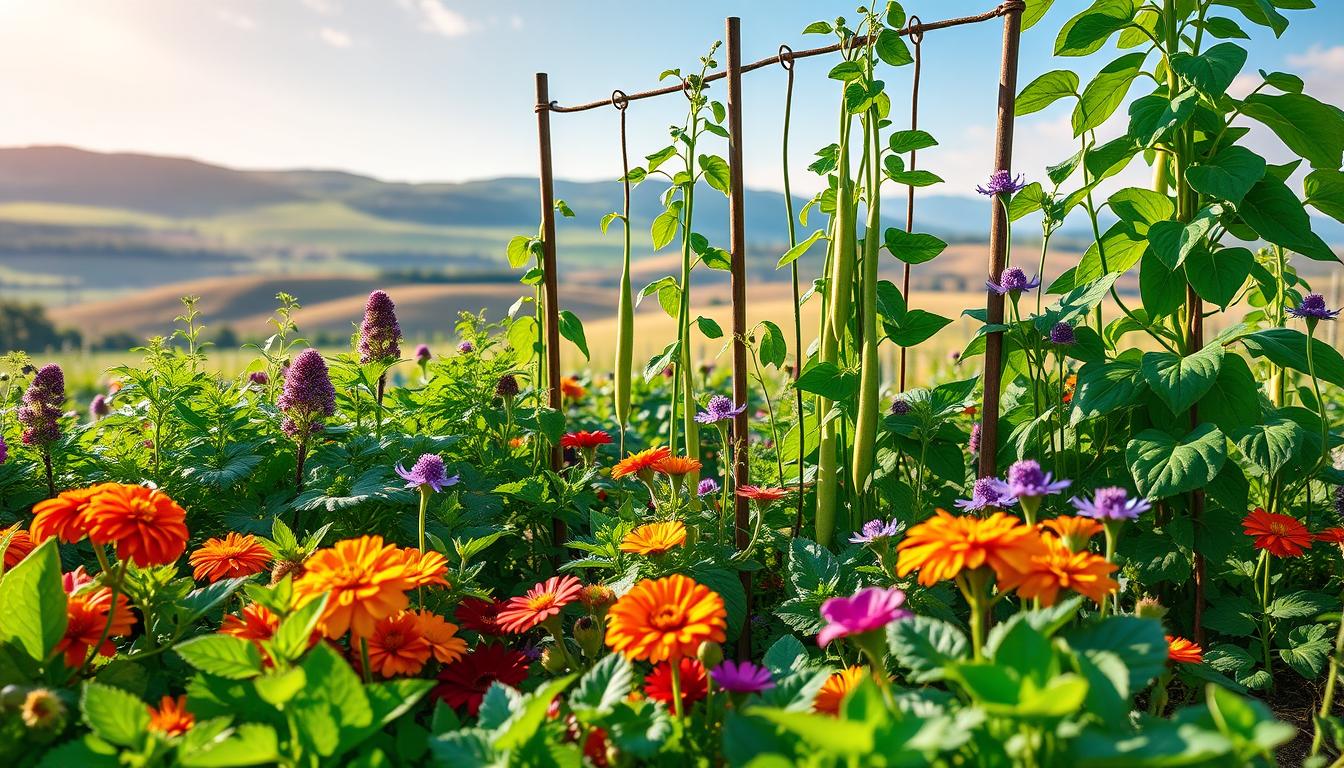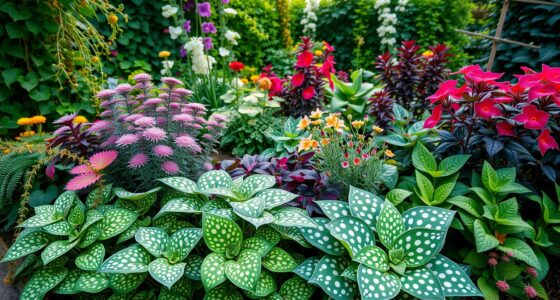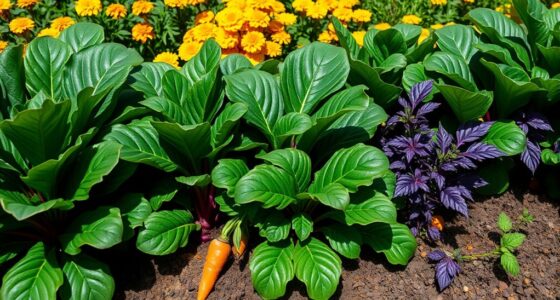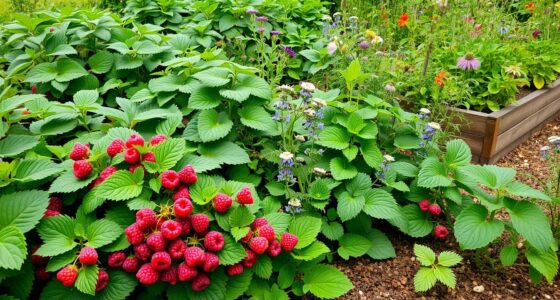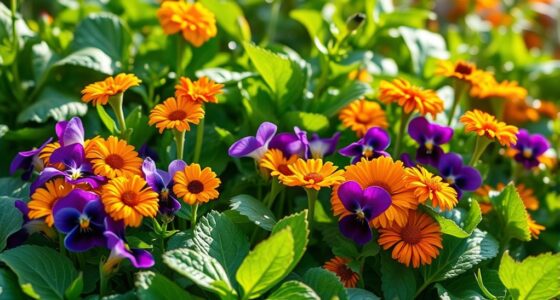Picture stepping into your garden, the sun warm on your face, and the sound of nature wrapping around you like a comforting embrace. As you survey your thriving landscape, you can’t help but feel a sense of pride watching your bean plants flourish. You know the secret to this bounty—the art of companion planting. By choosing the right companions for your beans, you can significantly enhance soil health, improve growth, and even deter pests. In this guide, we will explore the best plants to plant with beans, ensuring your garden not only survives but thrives with a rich tapestry of life.
Key Takeaways
- Companion plants for beans can enhance soil health and promote growth.
- Understanding the relationships between plants is key to successful bean companion planting.
- Using the best plants to plant with beans can maximize your garden’s productivity.
- Effective pest control can be achieved through strategic companion planting.
- A diverse garden helps cultivate a thriving ecosystem around your beans.
Why Companion Planting Matters for Beans
Companion planting serves as a crucial technique for enhancing the vitality and productivity of bean plants. This method revolves around strategically selecting plants that can work together, resulting in a healthier garden ecosystem. The benefits of companion plants extend far beyond basic growth, encompassing soil enrichment, pest management, and overall plant health.
Benefits of Companion Plants
Integrating companion plants can significantly boost your garden’s efficiency. For instance, legumes like beans are renowned for their ability to fix nitrogen in the soil. This natural process enriches the earth, providing vital nutrients for neighboring plants. This healthy soil ecosystem fosters improved growth rates and can lead to more abundant harvests. Additionally, selecting companions that bloom alongside your beans brings a spectrum of colors and diversifies your garden.
How They Improve Growth
Utilizing effective planting combinations heightens the overall growth potential of your beans. Certain plants, when paired with beans, can promote stronger root systems and enhance moisture retention in the soil. These growth enhancements cultivate a more robust garden where all plants thrive, maximizing the output you can expect from each growing season.
Pest Control and Soil Health
Implementing pest control strategies through companion planting is invaluable. Many companion plants act as natural deterrents for harmful insects, thus providing a shield for your beans. For example, marigolds and nasturtiums are known to repel pests, protecting the health of your crops. Coupled with sound soil health solutions that ensure nutrient balance and moisture levels, these strategies lead to a thriving garden filled with flourishing plants.
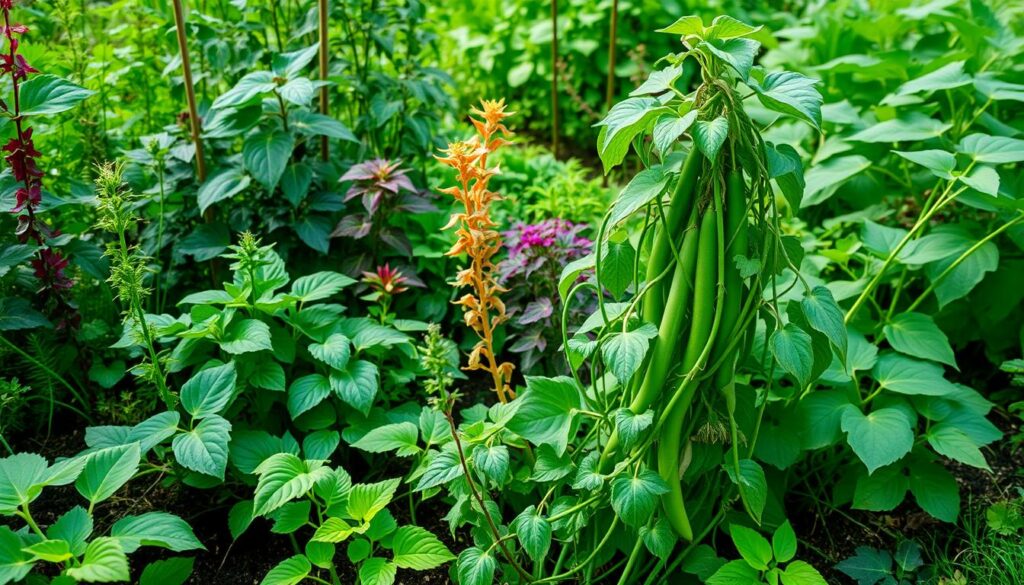
Best Companion Plants for Beans
Choosing the best companion plants for beans can significantly enhance your garden’s productivity. Some plants naturally support beans by providing essential benefits such as structural support, pest deterrence, and soil improvement. Below are three excellent companions for your bean plants that create a flourishing ecosystem in your garden.
Corn: A Natural Support Structure
Corn serves as a superior support structure for climbing bean varieties. As beans grow upward, corn provides much-needed stability. The roots of corn occupy different soil levels compared to beans, reducing competition for nutrients. This symbiosis maximizes growth potential and enhances the overall yield of your garden.
Marigolds: Pest Deterrents
Known for their vibrant colors, marigolds are also among the best companion plants for beans due to their ability to deter pests. They emit specific compounds that repel harmful insects, making them ideal partners with beans. When you incorporate marigolds in your garden, you not only add beauty but also protect your beans from potential pests.
Radishes: Soil Aeration Helpers
Radishes play a crucial role in companion planting beans and vegetables by improving soil health. Their deep root systems aerate the soil, which enhances water drainage and root respiration. This connection ensures that beans receive sufficient oxygen and nutrients, promoting healthier growth overall.
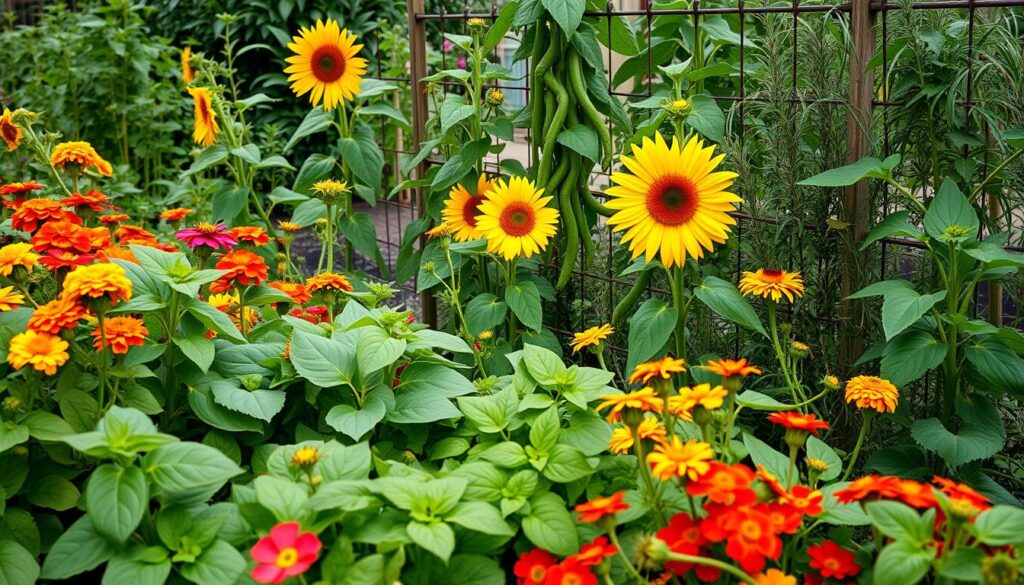
Together, corn, marigolds, and radishes showcase the importance of companion planting for your beans. These combinations create a harmonious environment that fosters growth, minimizes pests, and optimizes soil health, setting the stage for a bountiful harvest.
Legumes and Their Unique Companion Benefits
Legumes, such as beans, offer remarkable advantages as companion plants due to their unique ability to harness nitrogen from the atmosphere, enriching the soil. This process, known as nitrogen fixation, plays a critical role in promoting healthy plant growth and supports neighboring plants by enhancing soil fertility.
Nitrogen Fixation Process
The nitrogen fixation process occurs when legumes form a symbiotic relationship with specific bacteria in their root nodules. These bacteria convert atmospheric nitrogen into a usable form that plants can absorb. The nitrogen fixation benefits extend not only to legumes themselves but also to companion plants, providing them with essential nutrients that encourage robust growth.
Enhancing Soil Fertility
By incorporating legumes into your gardening plan, you significantly boost soil fertility. The organic matter from decaying legume plants contributes to a richer soil structure, which improves moisture retention and nutrient availability. This leads to enhanced growth for all plants in the vicinity, showcasing the legume planting advantages beyond their direct benefits.
Partners in Growth
Legumes thrive in diverse planting combinations, forming partnerships with various crops. A classic example is the Three Sisters method, where beans provide necessary support for corn while enhancing soil quality for squash. Such relationships underscore the synergy of combining different plants, emphasizing the mutual growth benefits in your garden.
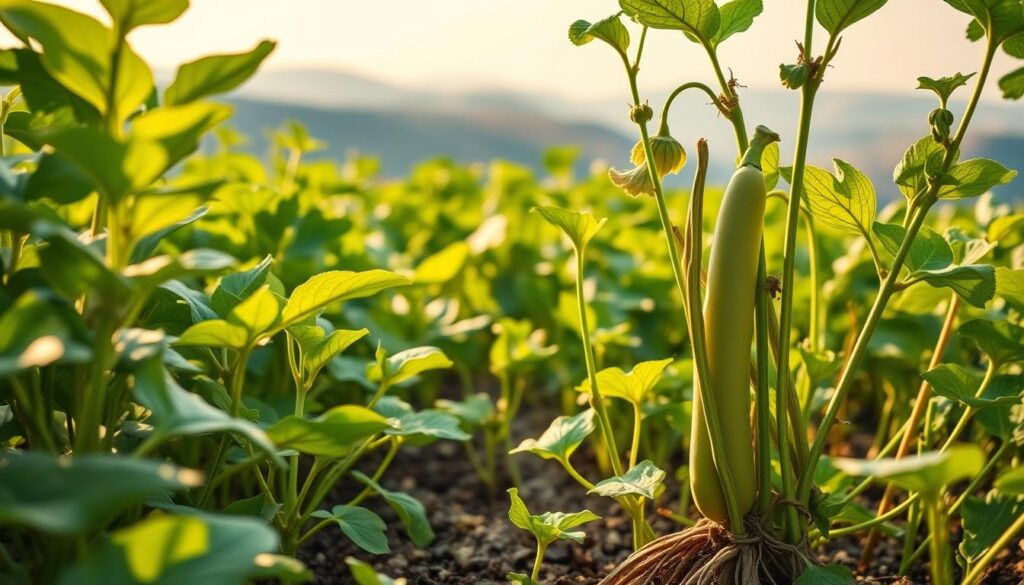
Vegetables that Thrive Alongside Beans
When planning your garden, consider the advantages of pairing beans with other vegetables. Certain selections not only flourish but also provide complementary benefits that can enhance growth and productivity. Here are some of the best companion vegetable selections that grow well with beans.
Squash: A Ground Cover Protector
Squash is a fantastic choice for planting alongside beans. This vegetable provides a natural ground cover, helping to maintain soil moisture while inhibiting weed growth. The broad leaves of squash can shield the soil from harsh sunlight, creating a beneficial microclimate for bean plants.
Potatoes: Space Efficiency
Potatoes are known for their efficiency in utilizing garden space. When placed near beans, they gain protection from pests, which can enhance their growth. This combination allows both vegetables to thrive while maximizing the use of available garden area.
Cucumbers: Utilizing Vertical Space
Cucumbers flourish alongside beans due to the nitrogen fixation process that beans facilitate in the soil. As cucumbers climb, they utilize vertical space effectively, leaving ground soil for beans. This synergy benefits both crops, promoting a robust harvest.

Herbs That Make Great Companions for Beans
Incorporating herbs into your bean garden not only enhances the flavors but also offers various advantages with pest management. The unique characteristics of herbs that benefit beans can create a thriving ecosystem, making these plants essential companions. Let’s explore some of the top herbs to consider.
Basil: Flavor Enhancer and Pest Repellent
Basil stands out as one of the best companion herbs for pest control. Its strong aroma effectively repels common pests like aphids and whiteflies, ensuring your bean plants stay healthy. Alongside pest prevention, basil enhances the flavor profile of beans, making your harvest even tastier.
Oregano: Strong Aromatics and Benefits
Oregano’s robust scent offers both culinary and ecological benefits. The strong aromatics improve the overall health of surrounding plants, including beans. These herbs not only deter pests but also attract beneficial insects that support a balanced garden ecosystem, reinforcing the importance of companion herbs for pest control.
Cilantro: Attracting Beneficial Insects
Cilantro plays a crucial role in attracting beneficial insects such as ladybugs and lacewings, which prey on harmful pests. This dynamic is essential in maintaining the health of your bean plants. Using cilantro as one of the herbs that benefit beans will encourage a natural repellent against common threats.

Flowers that Benefit Bean Growth
Incorporating flowering plants for beans can significantly enhance their growth while improving the overall health of your garden. Certain flowers not only beautify your space but also serve a functional purpose. Here are three excellent flowering plants that support bean cultivation.
Sunflowers: Natural Shade and Protection
Sunflowers stand tall, providing natural shade for beans, which can help maintain optimal soil temperature. Their robust structure offers protection against harsh weather, allowing beans to thrive. Planting sunflowers alongside beans can promote better growth and resilience.
Nasturtiums: A Trap for Pests
Nasturtiums act as a trap crop, effectively drawing pests away from your bean plants. These vibrant flowers not only add color to your garden but also protect beans from aphids and other harmful insects. By sowing nasturtiums near beans, you create a natural barrier that enhances their health.
Borage: Pollinator Magnet
Borage is an exceptional choice for attracting beneficial insects. The presence of borage increases pollinator activity, leading to improved seed set and overall yield in your bean plants. With its striking blue flowers, this plant contributes to biodiversity, enriching your garden ecosystem.
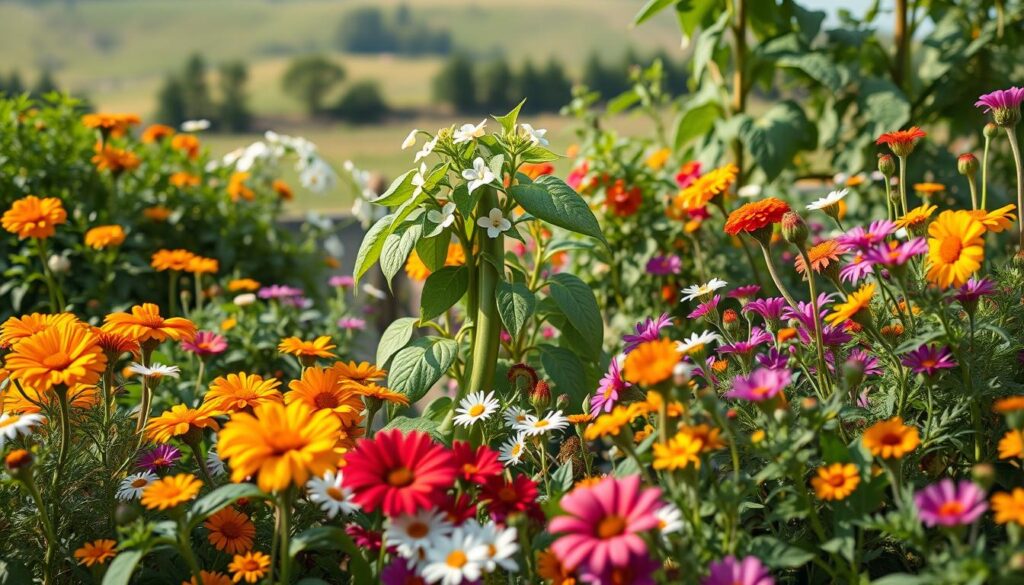
| Flowering Plant | Benefit to Beans | Additional Features |
|---|---|---|
| Sunflowers | Provides shade and protection | Heightens environmental resilience |
| Nasturtiums | Attracts pests away from beans | Vibrant colors beautify the garden |
| Borage | Attracts beneficial insects | Enhances biodiversity |
By strategically planting these flowering plants for beans, you can foster a healthier garden environment while simultaneously boosting your bean harvests.
Avoiding Negative Companion Plants for Beans
When growing beans, it’s essential to consider which plants can hinder their growth. Negative companion planting relationships can severely impact the productivity of your bean plants. Understanding the plants to avoid with beans will help you cultivate a thriving garden environment.
What Not to Plant with Beans
Several plants have been shown to create challenges for beans. Alliums, such as onions and garlic, are notorious for stunting bean growth due to their strong chemical compounds. Other culprits include sunflowers and fennel, which can release substances harmful to beans. Keeping these plants at a distance will create a more favorable environment for your beans.
Recognizing Harmful Companions
Recognizing harmful companions is crucial in ensuring the health of your garden. Understanding the relationships between different plant species enables you to avoid pairing those that negatively affect each other. Maintaining a distance between beans and specific species like the aforementioned alliums is paramount. This simple act can lead to a more successful growing season.
Tips for Successful Pairings
To foster growth in your beans, focus on beneficial pairings while steering clear of negative influences. Consider planting beans with supportive crops such as corn, which can provide structural support and enhance growth. Observing your garden and adjusting plant placements can build a healthy, flourishing ecosystem. By avoiding the plants to avoid with beans, you help create a positive atmosphere for your crops to thrive.

Planting Tips for Successful Companion Gardens
Creating a thriving companion garden involves careful planning and attention to detail. By following specific guidelines, you can optimize plant growth and enjoy fruitful harvests. Consider various companion planting strategies that enhance relationships among plants and improve growth outcomes. The following tips will help you establish a successful garden.
Choosing the Right Location
Selecting an appropriate site is crucial for successful companion planting. Focus on sunny to partially shaded areas while avoiding waterlogged conditions. Well-drained soil plays a significant role in supporting bean growth. Assess the plant growth location criteria to ensure optimal light and moisture for your garden.
Timing Your Planting Correctly
Timing your plantings significantly impacts growth results. Wait until after the last frost before sowing beans. Proper scheduling enhances the conditions for growth and cooperation among companion plants. Integrating robust support structures, such as corn, is essential to help the beans thrive.
Maintaining Soil Health for Companion Plants
Healthy soil translates to vibrant plants. Regularly maintain your garden’s soil through techniques such as mulching and crop rotation. These practices promote nutrient retention and overall soil health, benefitting all plants involved in your companion planting strategies. Continuous monitoring will yield optimal results and ensure a productive garden.
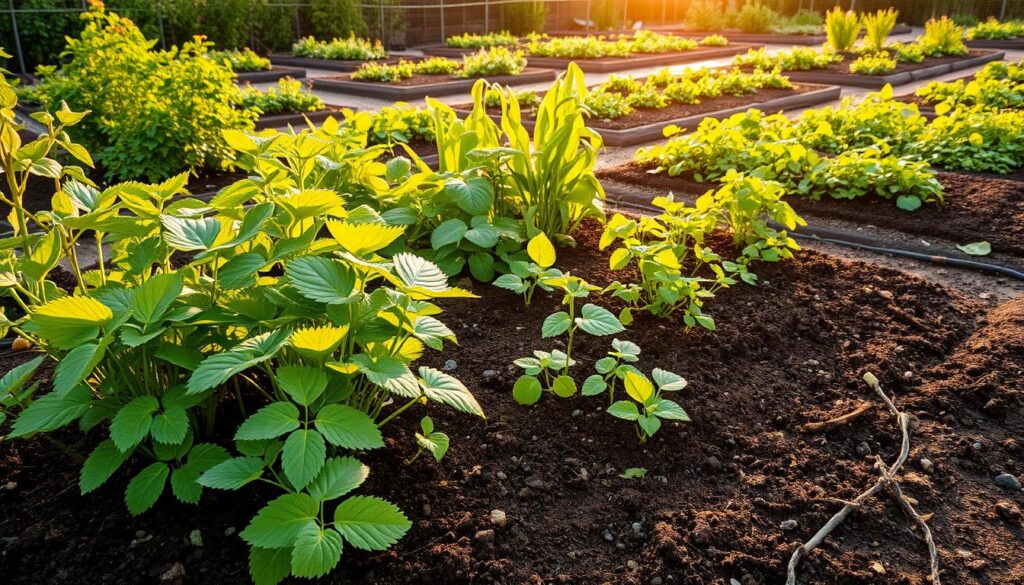
Care and Maintenance for Your Companion Plants
Caring for your companion plants involves a few key strategies, particularly focusing on watering and fertilization for beans. Understanding each plant’s needs can significantly enhance your garden’s productivity. Implementing reliable care techniques will ensure both beans and their companions thrive together.
Watering Needs: Understanding Companion Requirements
Watering is crucial for maintaining healthy companion planting care. Beans like moist soil that is well-drained to avoid waterlogging. Regular watering, approximately once a week, ensures that your beans receive enough moisture without becoming saturated. Pay attention to the surrounding plants as well, as they may have varying water needs.
Fertilization: How to Nourish Both Plants
Fertilization techniques play a vital role in maintaining robust growth. Beans are unique due to their ability to fix nitrogen in the soil. Using organic fertilizers, particularly those rich in nitrogen, will help support the beans while providing essential nutrients to their companions. Be mindful of the quantity to avoid overwhelming plants with too much fertilizer.
Pest Management Strategies
Effective pest control can be achieved through sustainable approaches. Integrated pest management strategies, such as introducing beneficial insects like ladybugs or using organic repellents, can protect your garden from harmful pests. Regular monitoring will help you assess both your beans and companion plants for any signs of distress or unwanted visitors.

Harvesting Tips for Beans and Their Partners
Successfully harvesting beans and their partners is essential for maximizing yields and ensuring the best flavor. Understanding the right timing and methods can significantly impact your harvest experience. This section will guide you through the optimal bean harvesting techniques, how to harvest companion plants, and the best practices for preserving bean harvests.
When to Harvest Beans
Beans should be harvested at the right moment to achieve the best flavor and quality. Look for the following signs to determine the ideal time for picking:
- The pods should be firm to the touch.
- The beans inside the pods should be well-formed, but not yet fully dried.
- A slight bend in the pod indicates readiness for harvest.
Harvesting Companion Plants
While beans have specific signs for harvesting, their companion plants may be in different growth stages. Be observant of your garden. For example:
- Corn can be harvested once the ears feel plump and the silks turn brown.
- Marigolds can be cut back once their blooms start to fade.
Understanding each plant’s growth cycle will help you optimize your overall harvest.
Preserving Your Harvest
Proper preservation methods are crucial for enjoying your harvest well into the future. Here are some effective strategies for preserving your bean harvests:
- Blanching: Briefly immerse beans in boiling water to neutralize enzymes, then rapidly cool in ice water.
- Freezing: Store blanched beans in airtight bags to capture their freshness and flavor.
- Drying: For long-term storage, allow beans to dry thoroughly before placing them in jars.
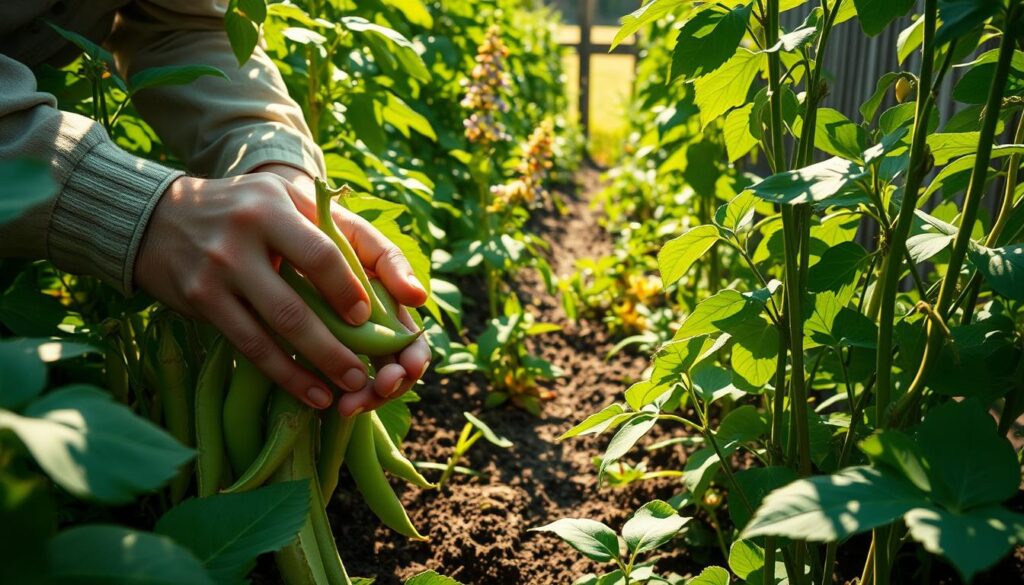
Maintaining records during your harvesting process can provide valuable insights for future planting cycles. You can track which beans thrived alongside their companions, enhancing your upcoming gardening efforts.
| Harvest Technique | Description |
|---|---|
| Blanching | Boil, then ice to preserve flavor and texture. |
| Freezing | Store in airtight bags for long-term freshness. |
| Drying | Complete drying for optimal shelf life. |
Seasonal Considerations for Planting Beans
Understanding the timing and maintenance of your bean crops is essential for a productive harvest. Effective seasonal planting tips for beans begin with careful planning during spring and continue through the summer and into the fall. Each stage of the growth cycle requires attention to specific needs, especially when managing summer growth and preparing for harvest.
Spring Planting Strategies
As winter fades, wait for soil temperatures to rise above 60°F before planting your beans. This temperature is key to ensuring optimal germination and growth. Begin by preparing your garden bed, incorporating organic matter to enhance moisture retention. Use raised rows to improve drainage, which is crucial for young plants in spring rains.
Summer Growth Maintenance
Once your beans are established, focus on managing summer growth through regular watering and monitoring for pests. Aim for consistent moisture without waterlogging. Consider mulching around your plants to suppress weeds and maintain your soil’s temperature. Check for common pests, as early intervention will keep your plants healthy and thriving.
Preparing for Fall Harvest
As summer transitions to fall, begin preparing for harvesting by assessing your bean plants. If you plan to plant cover crops, choose options that complement your beans and enhance future soil health. Beans fix nitrogen in the soil, benefiting the subsequent crops. Timing your harvest ensures maximum yield, so keep an eye on the pods and gather them when they are fully formed but still tender.
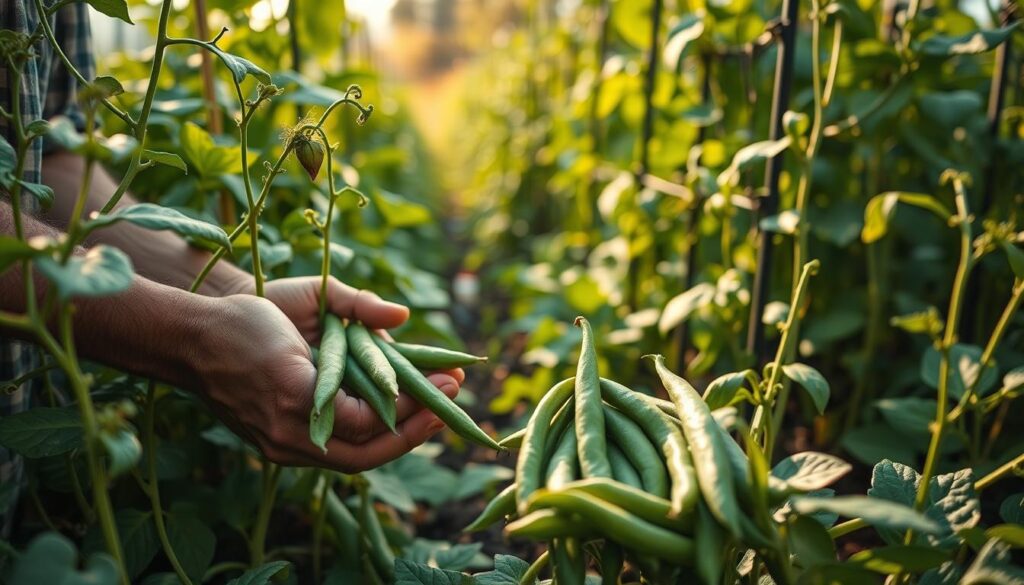
Expanding Your Companion Planting Knowledge
Enhancing your gardening skills requires curiosity and exploration. You can find a wealth of companion planting resources that support your journey in learning about gardening. Various tools and materials are available to help you deepen your understanding and successfully implement companion planting in your garden.
Resources for Further Learning
Dive into the world of gardening through informative resources. Books and guides on companion planting offer practical tips and techniques that cater to different skill levels. You’ll be surprised at the range of information available. These resources can help you understand the dynamics between different plants and their effects on each other.
Gardening Guides and Books
Consider investing in gardening books that focus on companion planting. Titles such as “Carrots Love Tomatoes” and “The Vegetable Gardener’s Bible” provide comprehensive information and illustrate successful companion planting strategies. With these guides, you can learn to pair plants that thrive together, enhancing not only growth but also pest management.
Online Communities and Forums
Engaging with online gardening communities can provide invaluable insights. Forums on platforms like Reddit or dedicated gardening websites allow you to connect with other gardening enthusiasts. Sharing experiences and asking questions will broaden your understanding and offer new perspectives on companion planting.
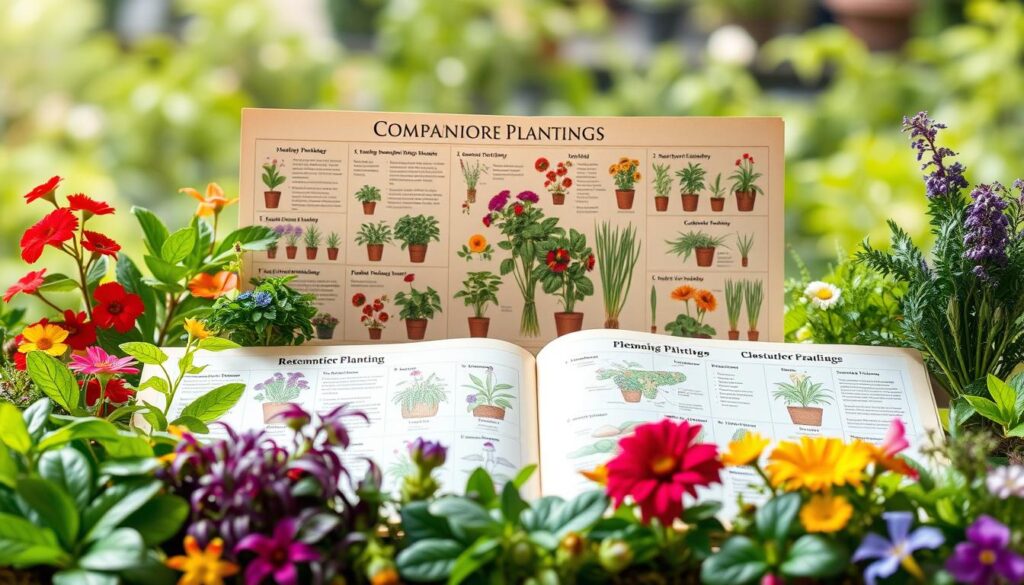
Making the Most of Your Companion Planting Experience
Enhancing your gardening experience can be a fulfilling journey, especially when it comes to companion planting. One of the most effective methods for improvement is by keeping a garden journal. This practice allows you to capture your successes, failures, and observations while documenting plant growth over time. By noting what works well together and what doesn’t, you can create a valuable resource that assists you in refining your gardening techniques.
Furthermore, don’t hesitate to experiment with different combinations of plants. The beauty of companion planting lies in its potential for discovery. You might find unexpected partnerships that lead to robust growth and healthier crops. Your garden journal will serve as a guide, helping you track which pairings yield the best results, thereby enhancing your gardening experience.
Finally, take the time to savor the fruits of your labor. Gardening is as much about enjoying the process as it is about the harvest. Whether you’re gathering fresh beans or appreciating the vibrant flowers that fill your garden, let yourself relish these moments. This connection to your garden can turn simple growing into a rewarding adventure that goes far beyond cultivating food.
